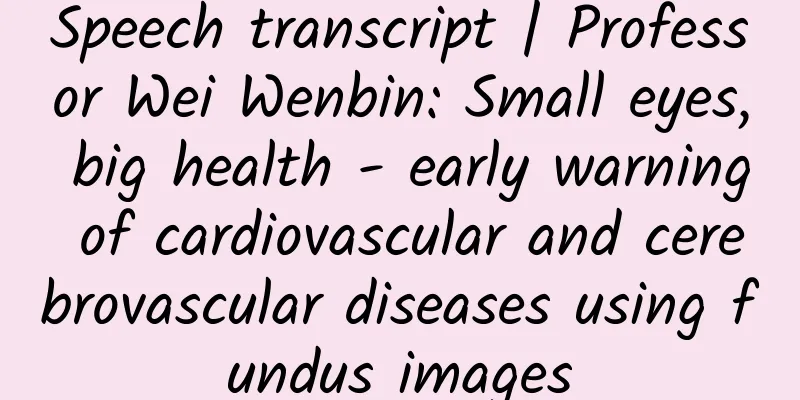Speech transcript | Professor Wei Wenbin: Small eyes, big health - early warning of cardiovascular and cerebrovascular diseases using fundus images

|
From June 5 to 6, 2021, the 2021 Global Artificial Intelligence Technology Conference was successfully held in Hangzhou, under the guidance of the China Association for Science and Technology, the Chinese Academy of Sciences, the Chinese Academy of Engineering, and the People's Government of Zhejiang Province, hosted by the China Artificial Intelligence Society and the People's Government of Hangzhou, undertaken by the Preparatory Group of the People's Government of Yuhang District, Hangzhou, and implemented by the Management Committee of the Future Science and Technology City of Hangzhou, Zhejiang. At the Charm and Challenge - Smart Healthcare and Elderly Health Cross-Innovation Forum held on June 5, Professor Wei Wenbin, Vice President and Professor of Beijing Tongren Hospital Affiliated to Capital Medical University and a leading talent of the National "Ten Thousand Talents Plan", gave us a wonderful speech entitled "Small Eyes, Big Health - Early Warning of Cardiovascular and Cerebrovascular Diseases with Fundus Imaging". Wei Wenbin Vice President and Professor of Beijing Tongren Hospital, Capital Medical University Leading talents of the National “Ten Thousand Talents Plan” The following is the transcript of Professor Wei Wenbin’s speech: Today I will share with you some of my experiences in ophthalmology in overall health management. The eye is the only organ in the body that can directly see blood vessels and nerves. It is also a window to the health of the whole body, reflecting the health of the whole body. Because the circulation of the retina has the same anatomical and physiological characteristics as the brain and coronary circulation, and the optic nerve is a part of the central nervous system, they have mutual reflections in pathology and physiology, so the fundus may become a window for cardiovascular and cerebrovascular observation. Cardiovascular and cerebrovascular diseases are still the primary diseases that threaten human health and even life, and are also the most burdensome chronic diseases. More than 3 million people die from cardiovascular and cerebrovascular diseases in my country every year. Therefore, early identification of risk groups and moving the threshold forward are major issues that need to be addressed in the prevention and treatment of chronic diseases. Traditional cardiovascular and cerebrovascular risk factors cannot directly reflect target organ damage, and the eyes may serve as a window for early warning of cardiovascular and cerebrovascular diseases. The retinal arteries and veins originate from the internal carotid artery. With the help of software and technology, such as fundus photography, the retinal blood vessels are precisely measured and observed, and quantified through artificial intelligence, which has become an important means of clinical research. Nowadays, various imaging technologies in ophthalmology are developing very fast, including fundus photography, fluorescein angiography, optical coherence tomography (OCT) and optical coherence tomography angiography (OCTA). These imaging technologies are the specialties of ophthalmology. Because ophthalmology is mainly based on images, these fundus images can be used to achieve multimodal image fusion and quantification. Through quantitative image analysis, deep processing, detail segmentation and extraction, through the acquisition of three-dimensional blood vessels, precise layered measurement, choroid and retina, as well as one-dimensional, two-dimensional, three-dimensional and vascular function multi-level quantitative analysis, provide a basis for clinical diagnosis. We have conducted some preliminary research on predicting vascular standardization, and have used international and standardized quantitative measurement techniques in two-dimensional planes, three-dimensional sections and vascular functions, and established a large-scale population-based cohort study, as well as a full-dimensional database of retina and choroid standardization in natural populations. These data help us study the relationship between the retina and cardiovascular and cerebrovascular diseases. There have been some studies in the past on whether retinal vascular abnormalities are related to cardiovascular and cerebrovascular diseases. We have been studying this for 10 years, observing the relationship between retinal vascular abnormalities, including retinal vascular stenosis, arteriovenous cross-pressure, and the morphology of small blood vessels and cardiovascular and cerebrovascular diseases. We found that changes in retinal blood vessels are closely related to hypertension. Microvascular abnormalities are very common in people with hypertension. Vascular abnormalities in Chinese people increase with age, especially in rural areas. We have also conducted some prospective studies, mainly to study whether microvascular disease is caused by microcirculatory disorders. After five years of research data, it was found that localized arterial stenosis, crossing, and retinopathy are increasing, and are particularly closely related to hypertension. The incidence of retinal microvascular abnormalities has increased by 1.58 times; and it is related to the degree of blood pressure increase. For every 10 mmHg increase in mean arterial pressure, the incidence of vascular abnormalities increases by 1.58 times. We found that when blood pressure is well controlled, retinal microvascular abnormalities will significantly improve, so the improvement rate of retinal microvascular abnormalities is closely related to the degree of hypertension control, that is, hypertension and retinal microvascular abnormalities are significantly related, so retinal microvessels can be used as a target organ for good hypertension control. We conducted a "Kailuan Eye Disease Study" in Kailuan, which showed that retinal vascular abnormalities are closely related to carotid artery thickness and carotid artery plaques. We found that there is a clear relationship between carotid artery plaques, arteriosclerosis and retinal artery diameter, so retinal vascular arteriosclerosis is an indicator of carotid artery disease. Through fundus photography, it can be found that in addition to retinal blood vessels, we also hope to find more sensitive vascular indicators from fundus images to reflect cardiovascular and cerebrovascular diseases. Currently, ophthalmology has a system called OCTA (retinal vascular imaging), which can stratify and quantify the retinal blood vessels in 2.5 seconds. Using this technology, we have created a database of normal people's superficial retinal blood flow, deep retinal blood flow, and choroidal capillary blood flow. Diabetic patients with normal fundus, that is, in the preclinical stage of diabetic retinopathy, can be screened for diabetic retinopathy early through blood flow imaging technology, because diabetic retinopathy is the most important cause of blindness in diabetic patients. By observing the morphology and quantification of blood vessels through blood flow imaging technology, it can be found that when there is no problem with fundus photography of diabetic patients, there are already problems with retinal blood flow imaging. One-third of patients have "hollowing out" of the macular arch, as well as changes in the morphology and density of some capillaries, which helps us identify preclinical diabetic fundus lesions early. Blood flow imaging technology is used to study the relationship between fundus capillary density and diabetic nephropathy. For example, the density and perfusion density of retinal blood vessels are used to see if there is any relationship between them and renal function. Through research, it is found that for every 1 unit decrease in retinal capillary density, the incidence of urinary protein increases by 11%, and for every 1 unit decrease in blood flow density, the incidence of urinary protein increases by 17%, indicating that retinal blood vessel density, blood flow density and renal function are related. Therefore, quantitative analysis of retinal blood flow can be used as an effective monitoring indicator for diabetic nephropathy. Through fundus imaging, the manifestations of multiple sclerosis combined with optic neuropathy can also be observed, because the blood vessel density also decreases significantly. Some people abroad have used OCTA to study Alzheimer's disease (AD). The changes in the density of retinal choroidal blood vessels can be used as a biomarker for early diagnosis of AD, and can also be used as a method for follow-up monitoring of disease progression and judging drug efficacy. In addition to vascular density, changes in the retinal nerve fiber layer can also predict some systemic changes. Because OCT can accurately measure the thickness of the nerve fiber layer non-invasively, it has reached the resolution of histology and can accurately measure the thickness of the nerve fiber layer. Ordinary fundus photography can also show the distribution of the nerve fiber layer. We conducted a study involving more than 3,000 people and established a database of normal people's retinal nerve fiber layer. Because the thickness of the retina varies in different locations, and age, gender, and eye axis all have a certain impact, the thickness of the nerve fiber layer is closely related to age. Both red-free fundus photography and OCT can be used to observe nerve fiber layer defects, which can be classified according to the shape of the defects. Studies have found that nerve fiber layer defects are related to diabetes, and that diabetic patients have obvious damage to the retinal nerve fiber layer; some neurological diseases also have obvious defects in the retinal nerve fiber layer. We focused on the relationship between retinal nerve fiber layer defects and hypertension. Through a study of more than 3,000 people, we found that the nerve fiber layer defects in people with hypertension were twice as high as those in normal people, and the morphology was also significantly different. The thickness of the nerve fiber layer was closely related to hypertension. In addition, it was found that the loss of nerve fibers was also related to the grade of hypertension. The more severe the hypertension, the more severe the nerve fiber layer defect. Therefore, it provides an objective basis for the early prevention, control, treatment and follow-up of hypertension and the loss of nerve fiber layer. We conducted a five-year cohort study to observe the relationship between the retinal nerve fiber layer and the progression of hypertension. For people with nerve fiber layer defects, the risk of hypertension progression increased nearly five times after five years. In other words, people with nerve fiber layer defects had nearly five times the risk of significant progression of hypertension five years later. We also found a clear relationship between nerve fiber layer defects and cerebrovascular abnormalities, as well as between the carotid arteries. Through a large sample cohort study, it was confirmed that retinal nerve fiber layer defects and asymptomatic stroke, as well as acute stroke and stroke-related death are closely related, so nerve fiber layer defects can be used as a monitoring indicator for the full-course early warning of stroke. In addition, by detecting some changes in the choroid through OCT, we can see whether there is a relationship between systemic diseases. Because the choroid is generally invisible in the middle layer of the eyeball wall, with OCT images, we can layer and accurately measure the choroid image through deep image processing, detail segmentation, and tomographic quantification. We conducted a quantitative study of choroidal imaging in a population-based cohort and found that choroidal thickness can be used as a marker of aging. The choroid thins by 33 μm for every 10 years of age, which is significantly negatively correlated with age. Therefore, choroidal thickness can be used as a monitoring indicator for aging. At the same time, we also found that choroidal thickness is closely related to diabetes. The blood vessels in the choroid of diabetic patients, especially in the early stages, can cause choroidal thickening. The texture of the fundus is leopard-like. The choroidal texture of each person in the fundus photo is different. Just like face recognition, the leopard print can be graded and zoned to observe the degree of change in the leopard print fundus in the macula and around the optic disc to see how it is related to the whole body. Studies have found that this change in leopard print is related to the eye axis, age, and glaucoma. In other words, the older the person, the more obvious the leopard print. It was found that leopard print and age are positively correlated, which can be used as an indicator of human aging. The leopard print fundus is also negatively correlated with the BMI value, that is, the level of change in the leopard print of a particularly fat person is significantly different from that of a thin person; the leopard print changes more obviously in smokers, which is also obviously related to smoking. When we studied the relationship between leopard pattern and choroid thickness and cognitive dysfunction, we found that choroid thickness, leopard pattern fundus and cognitive dysfunction were significantly correlated. Therefore, eye abnormalities can be used as an independent warning sign for cognitive dysfunction. We have published some articles to confirm the results of the above studies, which have been well received by foreign colleagues. In addition to the correlation between leopard fundus and hypertension and cognitive dysfunction, it is also related to glomerular filtration rate and diabetes. The difference in leopard fundus and choroid research is very meaningful in clinical practice because it is related to age, BMI, smoking, cognitive dysfunction, hypertension, and reduced glomerular filtration rate, which indicates that the blood perfusion of the whole body is reduced. Therefore, changes in leopard fundus and choroid are also fundus manifestations of reduced blood perfusion of the whole body. The different textures of fundus images and fundus photos can reflect the whole body condition. Through a series of fundus images, including color fundus photographs, OCT and OCTA images, we can establish a disease warning and personalized health service system through artificial intelligence. We can also combine these ophthalmic images through some chronic disease management channels and platforms to improve our level of chronic disease management. At present, a fundus photo can reflect a lot of overall conditions, including a color photo that we studied can show age, weight, and some overall health conditions. In addition to photos, fundus images also have quite a lot of other images. Through big data and intelligent analysis, we can establish channels for chronic disease management and early warning through the Internet. In summary, in addition to diagnosing and treating ophthalmic diseases, ophthalmologists can serve as a window for chronic disease management and play a certain role in early warning of systemic diseases through the eyes; through fundus images and artificial intelligence analysis, they can achieve the effect of preventing and controlling systemic chronic diseases. Changes in retinal microvessels, blood flow, and retinal nerve fiber layers can be used to monitor cardiovascular and cerebrovascular diseases. We have further expanded the diagnosis of cognitive dysfunction, systemic microcirculation decline, renal function, and systemic organ changes through changes in the choroid, including choroid thickness and fundus texture. Today, through close cooperation between ophthalmologists, fundus imaging, and experts in the field of artificial intelligence, we have achieved "small eyes managing big health." (This report is compiled based on shorthand) |
>>: Seasonal skin sensitivity? It may not be your fault
Recommend
What causes women to have big eye bags?
Modern women are under great pressure in life. So...
Female breast development age
The age at which female breasts develop is genera...
If you love beauty, you should be careful about the "lumps of flesh" caused by ear piercing!
If you wear earrings well, your face will be smal...
What can pregnant women eat to replenish blood quickly without affecting the fetus?
The immediate adverse effect of anemia in pregnan...
Medicine for irregular menstruation
Menstruation is a manifestation of a woman's ...
Regarding "the last fall of the elderly", these core messages must be told to parents!
The sudden death of Academician Yuan Longping, th...
How to prepare hot pot dipping sauce? How to prepare hot pot clear soup base?
Hotpot, known as "Gudong Geng" in ancie...
Fallopian tube adhesion
Adhesions of the fallopian tube opening are a hea...
What should I do if there is blood congestion in the uterus? I must pay attention to it
Failure to pay attention to hygiene may cause int...
Celebrities reveal they have stomach cancer! These 5 types of people are particularly at risk, but one method can help prevent it!
Recently, a video in which Yu Donglai, chairman o...
What is the reason for frequent appendage pain?
Female friends nowadays do not take care of their...
What health care knowledge do middle-aged women have?
Middle-aged and elderly people are more likely to...
How to keep your breasts healthy
Women play an important role in life, but they al...
Hidden Disease--Drug-Induced Liver Injury
"Doctor, my child has been feeling weak and ...
What should I do if a little girl has body odor?
The problem of body odor is related to chromosoma...









